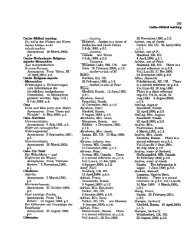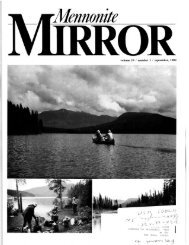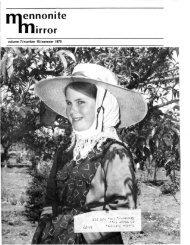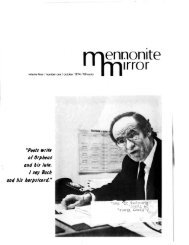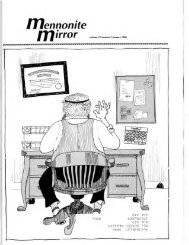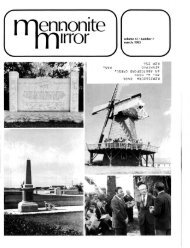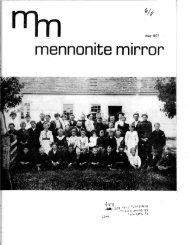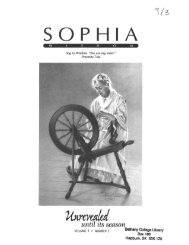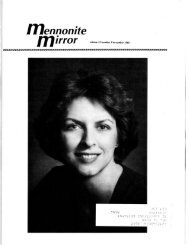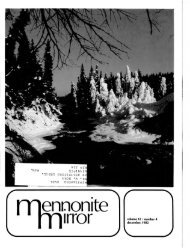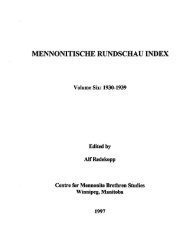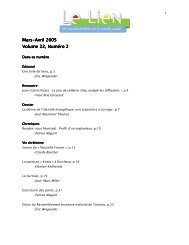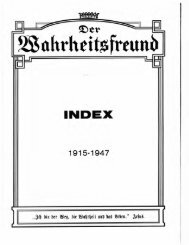• Donwood West opens new retirement option • - Canadian ...
• Donwood West opens new retirement option • - Canadian ...
• Donwood West opens new retirement option • - Canadian ...
Create successful ePaper yourself
Turn your PDF publications into a flip-book with our unique Google optimized e-Paper software.
walkin9 anywhere nor to give money to<br />
beggars. On one occasion as we (my colleague<br />
and a native chauffeur) were going<br />
to a restaura nt we were immediately surrounded<br />
by more than 20 beggars, some<br />
with infants, others on crutches. It was<br />
pitiful; yet if a coin were given to one we<br />
would have been mobbed by 100 others<br />
clamoring for the same. I felt guilty for<br />
following instructions. Christian ethics<br />
decried the "uncaring" non-action, but<br />
the reality of the situation dictated passive<br />
resistance.<br />
Whether becoming a member of a<br />
Mennonite church changed my life is difficult<br />
to say. I never experienced a "conversion';<br />
I lack the evangelical zeal to<br />
proselytize. When I read or hear ofmembers<br />
responding to the "Lord's call" to go<br />
abroad to carry out the "Lord's will," I<br />
wonder about my place in church. Am I<br />
unique in not thinking in these terms?<br />
Perhaps it is this lack of a firm commitment<br />
to the work of the church that leads<br />
to the feeling of not belonging to the<br />
church. I wonder, though, whether this<br />
feelinD of being an outsider is the fact that<br />
the congregation is so apparently<br />
homogeneous - essentially all German<br />
Mennonites. There used to be a black man<br />
who attended and for a time after the<br />
immigration of the "boat people," a family<br />
or two of Vietnamese. It's almost as if<br />
the church were a closed shop.<br />
The other major problem is the sheer<br />
size of the congregation. Members do not<br />
seem to know each other and do not recognize<br />
visitors, thereby giving an impression<br />
of aloofness. In over 20 years that I<br />
have been a member I have learned to<br />
know, perhaps five per cent of the members<br />
- the vast majority don't know me<br />
nor I them. I only know a very few as<br />
cherished friends, thanks to my wife who<br />
had known them prior to our becoming<br />
members. I would hazard a guess that<br />
had I been married to a non-caucasian,<br />
my membership would have been shortlived.<br />
Since the church is not a social club,<br />
socializing is not the most important element.<br />
I go to church in the hope that the<br />
ministers can interpret the gospels in<br />
modern relevant terms. Sometimes (with<br />
more regularity recently) the messages<br />
are less than inspiring. My Sunday morning<br />
attendance has declined accordingly.<br />
How relevant is the church to me currently?<br />
Perhaps as relevant as the church<br />
is to the community in which it is located.<br />
This is a rather poor assessment of me as<br />
a member. Until I feel comfortable being<br />
a member I'll probably feel like an outsider<br />
and ask "am I a Mennonite?"<br />
Dr. Robert Matsuo is a research chemist<br />
employed by the Board of Grain Commissioners.<br />
6/mennonite mirror/april 1988<br />
REVIEW<br />
Picture book about<br />
Latin-American Mennonites<br />
Reviewed by G. K. Epp<br />
Abe Warkentin, Gaste und Fremdlinge/<br />
Strangers and Pilgrims. Die Mennonitische<br />
Post. Derksen Printers, Steinbach,<br />
1987. 361 pages; $25.00.<br />
T his is a fairly comprehensive picture<br />
book, capturing Mennonite history in four<br />
South American countries. For each<br />
country, starting with Mexico, there is an<br />
introduction to land, people, and Mennonite<br />
immigration. The bilingual text<br />
(German/English) is most appropriate,<br />
since the book will be popular in the German-speaking<br />
South American colonies<br />
and also in Mennonite circles in Canada.<br />
As a matter of fact, if anybody wants a<br />
quick tour of our South America Mennonite<br />
settlements, he should pick up this<br />
book and enjoy the trip.<br />
Warkentin takes us to Mexico, Paraguay,<br />
Bolivia, and to Belize, introducing<br />
the reader to practically all aspects of<br />
Mennonite life in those countries. The<br />
author has collected an amazing amount<br />
of material and the photography is generally<br />
very good. Most helpful are also the<br />
maps of each colony. Thus, even nonhistorians<br />
will become interested in this<br />
unique presentation of Mennonite history<br />
in South America.<br />
After perusing this picture book, one<br />
cannot help but wish that Warkentin<br />
would eventually present us with a second<br />
volume covering the rest of Mennonite<br />
settlements in South America:<br />
Brazil, Argentine, Central America, etc.<br />
That would no doubt demand some<br />
detective work, but the Mennonitische<br />
Post, I am sure, is well-equipped to do<br />
that.<br />
In this context, I would have one little<br />
criticism. The quality of the printed pictures<br />
is not bad, but it could be more<br />
consistent. Among the many excellent<br />
reproductions, there are a few that could<br />
be better. This should not detract from my<br />
generally positive evaluation of this book,<br />
but, 'jemehrer hat,jemehrer will." And<br />
for people like myself, who are tempted to<br />
steal the occasional "slide" from this book<br />
for use in lectures on the South American<br />
story, that is important.<br />
In conclusion, I laud the idea and the<br />
successful completion of this project. The<br />
book is well done and should become a<br />
Mennonite picture book for every home,<br />
especially for South American Mennonites<br />
and for former South Americans.<br />
mm<br />
Coming Events<br />
April 29, 30: Convention of Associated<br />
Male Choruses of America & International<br />
Big Sing Convention. Hosted by<br />
Winnipeg Male Chorus. Location: Winnipeg<br />
Convention Centre.<br />
April 28, 29: Prairie Performances.<br />
Evening of Viennese Songs. Winnipeg Art<br />
Gallery.<br />
April 29, 30: <strong>West</strong>gate Operetta: The<br />
Sound of Music. Location: MBCI<br />
Auditorium.<br />
April 21, 22, 23: Winnipeg Mennonite<br />
Theatre - "Full Circle." <strong>West</strong> End Cultural<br />
Centre. 586 Ellice Ave. 8:05 p.m.<br />
MEDA Luncheon meeting: April 27,<br />
at noon, Sheraton Hotel Winnipeg; Roy<br />
Vogt will speak on What Can <strong>West</strong>ern<br />
Europe Teach Us About Labour-Management<br />
Relations. Tickets and information:<br />
944-1995, MEDA Office.<br />
May 7th: <strong>West</strong>gate Cyclathon.<br />
May 15: Winnipeg Singers 25th anniversary<br />
Tribute to Filmer Hubble and the<br />
Choristers. Identical program to that performed<br />
on May 30, 1963. John Martens,<br />
conductor. Crescent Fort Rouge United<br />
Church. 8 p.m.<br />
May 15: <strong>West</strong>gate Art and Music Festival.<br />
CMBC 12-6 p.m.<br />
May 29: The Mennonite Community<br />
Orchestra spring concert, <strong>new</strong> auditorium,<br />
Mennonite Brethren Collegiate<br />
Institute, 181 Riverton Avenue; 3:00 p.m.,<br />
with Rennie Regehr, Conductor.<br />
June 4 and 5: Charleswood Mennonite<br />
Church, 25th anniversary and homecoming;<br />
call church for information.<br />
I I



